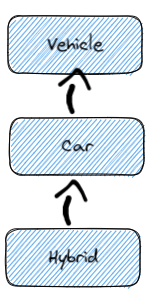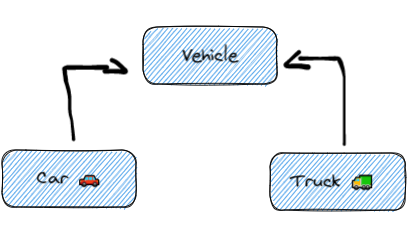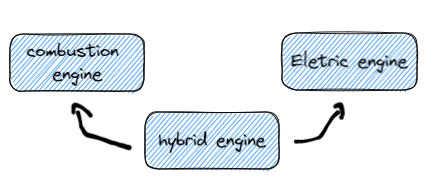Inheritance
Inheritance is a way to create a new class from an existing class
We have two terminologies in inheritance:
- Parent Class -> this class allows the reuse of its public properties in another class
- Child Class -> this class inherits or extends the superclass(Parent Class)
pratical example:
class ParentClass:
# attributes of the parent class
class ChildClass(ParentClass):
# attributes of the child class
the child class inherits all the properties and methods of the Parent class an can acess and modify them.
another example:
class Vehicle:
def __init__(self, make, color, model):
self.make = make
self.color = color
self.model = model
def printDetails(self):
print("Manufacturer:", self.make)
print("Color:", self.color)
print("Model:", self.model)
class Car(Vehicle):
def __init__(self, make, color, model, doors):
# calling the constructor from parent class
Vehicle.__init__(self, make, color, model)
self.doors = doors
def printCarDetails(self):
self.printDetails()
print("Doors:", self.doors)
obj1 = Car("Suzuki", "Grey", "2015", 4)
obj1.printCarDetails()
The super function
the super() function is a special function that is used to refer to the parent class of a subclass. It is typically used in the __init__ method of a subclass(child class)
for example:
class Animal:
def __init__(self, name, species):
self.name = name
self.species =species
class Cat(Animal):
def __init__(self, name, breed, toy):
super().__init__(name, species="Cat")
self.breed = breed
self.toy = toy
another example:
class Vehicle: # defining the parent class
fuelCap = 90
class Car(Vehicle): # defining the child class
fuelCap = 50
def display(self):
carrin = 80
if(carrin > super().fuelCap):
return super().fuelCap
else:
return self.fuelCap
obj = Car()
print(obj.display())
# super() refers the parent
The super() is also used with initializers
class ParentClass():
def __init__(self, a, b):
self.a = a
self.b = b
class ChildClass(ParentClass):
def __init__(self, a, b, c):
super().__init__(a, b)
self.c = c
obj = ChildClass(1, 2, 3)
print(obj.a)
print(obj.b)
print(obj.c)
Types of Inheritance
- Single
- Multi-level
- Hierarchical
- Multiple
- Hybrid
Single nheritance
Single Inheritance is the basic relation, when there is only a single class extending from another class
Multi-level Inheritance
When a class is derived from a class which itself is derived from another class
Hierarchical inheritance
When more than one class extends from the same class parent
class Vehicle: # parent class
def setTopSpeed(self, speed): # defining the set
self.topSpeed = speed
print("Top speed is set to", self.topSpeed)
class Car(Vehicle): # child class of Vehicle
pass
class Truck(Vehicle): # child class of Vehicle
pass
corolla = Car() # creating an object of the Car class
corolla.setTopSpeed(220) # accessing methods from the parent class
volvo = Truck() # creating an object of the Truck class
volvo.setTopSpeed(180) # accessing methods from the parent class
Multiple inheritance
When a class is derived from more than one base class, when a class has more than on immediate parent class
class CombustionEngine():
def setTankCapacity(self, tankCapacity):
self.tankCapacity = tankCapacity
class ElectricEngine():
def setChargeCapacity(self, chargeCapacity):
self.chargeCapacity = chargeCapacity
# Child class inherited from CombustionEngine and ElectricEngine
class HybridEngine(CombustionEngine, ElectricEngine):
def printDetails(self):
print("Tank Capacity:", self.tankCapacity)
print("Charge Capacity:", self.chargeCapacity)
car = HybridEngine()
car.setChargeCapacity("250 W")
car.setTankCapacity("20 Litres")
car.printDetails()
###
Hybrid inheritance
Is a combination of Multiple and Multi-level
- CombustionEngine IS A Engine.
- ElectricEngine IS A Engine.
- HybridEngine IS A ElectricEngine and a CombustionEngine.



